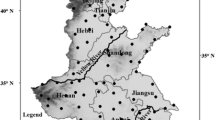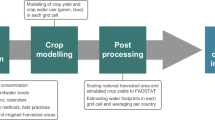Abstract
Spatially explicit assessments of consumptive water use (CWU) are still at an early stage, and partitioning of CWU has rarely been studied on large scales. In this article, CWU is assessed for China’s cropland with a spatial resolution of 30 arc-minutes. The partitioning of CWU is discussed through the simulation of transpiration ratios. The total CWU for Chinese cropland was 839 km3/a during 1998–2002. Spatial distribution of CWU is closely related to cropland area and crop production with the highest CWU in the North China Plain. Transpiration accounts for two-thirds of CWU. The transpiration ratio is affected by precipitation and irrigation. Transpiration ratios are higher in irrigated systems than in rainfed systems when precipitation is low. Competition of water use will impose pressure on China’s irrigation systems in the near future, and it will have a far-reaching effect on the partitioning of consumptive water use. Attention should be paid to green water management and technological improvements to guarantee China’s water and food security.
Similar content being viewed by others
References
Falkenmark M, Lannerstad M. Consumptive water use to feed humanity-curing a blind spot. Hydrol Earth Syst Sci, 2005, 9(1): 15–28
Liu J, Zehnder A J B, Yang H. Global consumptive water use for crop production: The importance of green water and virtual water. Water Resour Res, 2009, 45(5): W05428
Döll P, Kaspar F, Alcamo J. Computation of global water availability and water use at the scale of large drainage basins. Math Geol, 1999, 4: 111–118
Vörösmarty C J, Green P, Salisbury J, et al. Global water resources: Vulnerability from climate change and population growth. Science, 2000, 289(5477): 284–288
Rost S. Agricultural green and blue water consumption and its influence on the global water system. Water Resour Res, 2008, 44(9): W09405
Lauenroth W, Bradford J. Ecohydrology and the partitioning AET between transpiration and evaporation in a semiarid steppe. Ecosyst, 2006, 9(5): 756–767
Lawrence D M, Thornton P E, Oleson K W, et al. The partitioning of evapotranspiration into transpiration, soil evaporation, and canopy evaporation in a GCM: Impacts on land-atmosphere interaction. J Hydrometeorol, 2007, 8(4): 862
Liu J, Williams J R, Zehnder A J B, et al. GEPIC-modelling wheat yield and crop water productivity with high resolution on a global scale. Agric Sys, 2007, 94(2): 478–493
Liu J. A GIS-based tool for modelling large-scale crop-water relations. Environ Modell Softw, 2009, 24(3): 411–422
Ritchie J T. A model for predicting evaporation from a row crop with incomplete cover. Water Resour Res, 1972, 8(5): 1204–1213
Hargreaves G H, Samani Z A. Reference crop evapotranspiration from temperature. Appl Eng Agric, 1985, 1(2): 96–99
Williams J R, Jones C A, Kiniry J R, et al. The EPIC crop growth model. Trans ASAE, 1989, 32(2): 497–511
Mitchell T D, Jones P D. An improved method of constructing a database of monthly climate observations and associated high-resolution grids. Int J Climatol, 2005, 25(6): 693–712
Liu J, Williams J R, Wang X, et al. Using MODAWEC to generate daily weather data for the EPIC model. Environ Modell Softw, 2009, 24(5): 655–664
Batjes N H. ISRIC-WISE derived soil properties on a 5 by 5 arc-minutes global grid. In: International Soil Reference and Information Centre (ISRIC). Netherlands: ISRIC, 2006
Ramankutty N, Evan A T, Monfreda C, et al. Farming the planet: 1. Geographic distribution of global agricultural lands in the year 2000. Global Biogeochem Cycles, 2008, 22(1): GB1003
Portmann F, Siebert S, Bauer C, et al. Global Data Set of Monthly Growing Areas of 26 Irrigated Crops. Frankfurt: Institute of Physical Geography, 2008
Chapagain A K, Hoekstra A Y. Water Footprints of Nations. Delft: UNESCO-IHE, 2004
MWR. China Water Resources Bulletins (in Chinese). Beijing: Ministry of Water Resources, 2005. http://www.mwr.gov.cn/
Kang S, Gu B, Du T, et al. Crop coefficient and ratio of transpiration to evapotranspiration of winter wheat and maize in a semi-humid region. Agr Water Manage, 2003, 59(3): 239–254
Xie X, Wu K. A calculation model about transpiration water requirement in wheat field (in Chinese). ACTA Geographica Sinica, 1997, 52(6): 528–535
Author information
Authors and Affiliations
Corresponding author
Additional information
Supported by the Beijing Municipal Science and Technology Commission Project (Grant No. D09040900400000)
Rights and permissions
About this article
Cite this article
Liu, J. Consumptive water use in cropland and its partitioning: A high-resolution assessment. Sci. China Ser. E-Technol. Sci. 52, 3309–3314 (2009). https://doi.org/10.1007/s11431-009-0347-2
Received:
Accepted:
Published:
Issue Date:
DOI: https://doi.org/10.1007/s11431-009-0347-2




